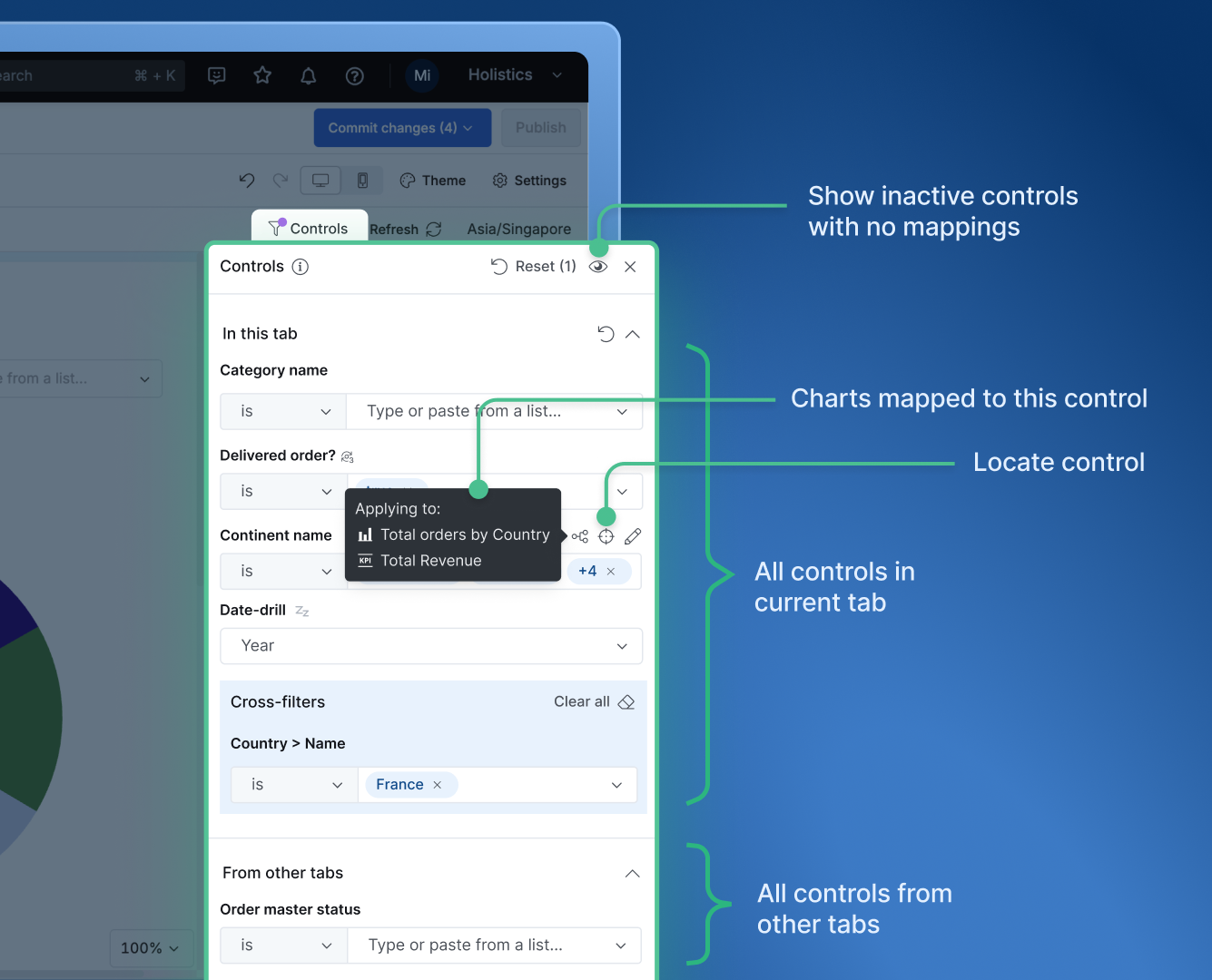Filter Data
Holistics supports filtering, allowing you to narrow down results by time, customer segment, product category, or any other dimension. This helps you focus on exactly what matters — without rebuilding your dashboards.
With Holistics filters, you can:
- Filter multiple charts at once
- Track which filters are active on your dashboard
- Share dashboard with prefilled filters
- Filter a single chart without affecting others
Filter multiple charts at once
When you need to see trends across your entire dashboard with a consistent lens — like analyzing Q3 data or focusing on a specific region — use dashboard filters to apply the same filter across multiple charts simultaneously.
Find the filter either directly on the dashboard or in the Filter Panel. After updating the values, click Apply to see all compatible visualizations refresh with the new data.
Things to know
-
Filtered views can be shared and bookmarked as the URL contains your filter state. Recipients see the same filtered view when they click your link.
-
Filters work on hidden fields - Dashboard filters work even when the filtered field isn't visible in the chart. For example, filter by customer segment without showing the segment column in your revenue table.
-
Filters can be scoped to affect all charts using the filtered field, or configured to apply to specific visualization blocks only (see Setup dashboard filter).
Track and manage filters across dashboard
When working with dashboards containing a large number of visualizations and filter mappings, understanding which filters affect which charts can become challenging—especially as you navigate between tabs.
The controls & filters panel provides a centralized view to help you manage this complexity.

What you can do with the controls & filters panel:
- See recently changed filters - Purple dots indicate which controls have newly applied values.
- View filters grouped by relevant context: Controls are grouped into "In this tab" and "From other tabs," making it clear which filters are relevant to your current view.
- Identify unmapped filters - Inactive controls with no mappings are displayed, helping you spot controls that need to be connected to visualizations.
- Quickly locate any filter - Click the locate icon next to any control to jump directly to it on the dashboard.
- View filter mappings on hover - Hover over any control to see which visualizations it affects. You can also click on any listed visualization to locate it.
- Reset filters at different levels - Reset controls to their default values at different levels: current tab only, specific tabs, or the entire dashboard.
- Interact with filters directly at the panel - Apply filter changes directly from the panel without returning to the dashboard view. This is especially useful for dense or lengthy dashboards.
Filter a single chart
When you want to drill into a specific chart without affecting other visualizations — like investigating an outlier or exploring a particular data segment — use local condition to isolate your analysis to just that chart.
Local conditions are filters that apply only to one specific visualization block, leaving all other charts unchanged. This gives you the flexibility to explore individual charts independently while maintaining the overall dashboard context.
You can add local conditions in multiple ways as below:
From the visualization's action bar
Hover over any chart and click on the filter icon in the action bar. You'll see the list of currently applied conditions in your chart, then you can configure your filter conditions.
From table context menu
For tables, click on any column header and select "Filter" to filter based on that column.
From data point right-click (Coming Soon)
This is an upcoming feature. The demo will be updated once it's released.
Right-click on any data point in a chart and select Filter. The filter popover opens with the selected dimension, allowing you to select any value you want to filter.
Things to know
-
Filters work on hidden fields - Block filters work even when the filtered field isn't visible in the chart. For example, filter by customer segment without showing the segment column in your revenue table.
-
Block filters are temporary and reset when the page refreshes. They're ideal for quick, exploratory analysis without permanently changing your dashboard view.
-
Block filters combine with dashboard filters - When both exist, they use AND logic, meaning both conditions must be met for data to be rendered.
Advanced Filtering Options
Holistics also supports other advanced filtering options:
Other scenarios you may encounter when applying filters
Ready to explore your data? Start with dashboard filters for broad analysis and use block filters for detailed investigation. For interactive data discovery, explore Cross-Filtering.